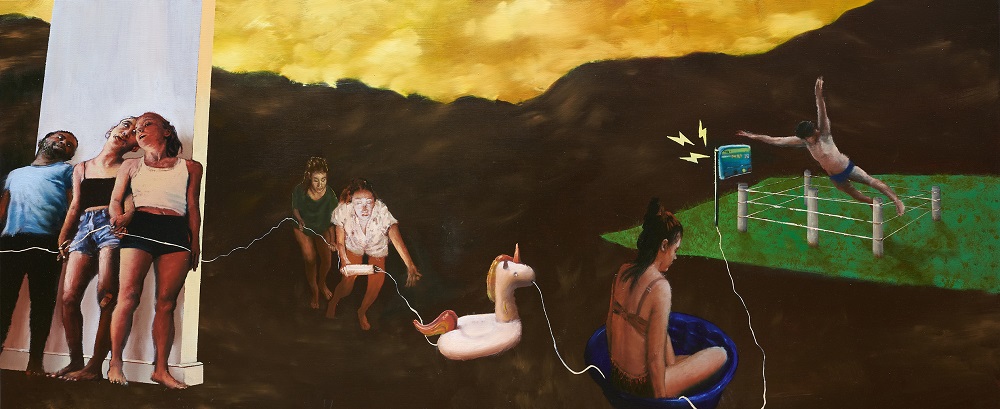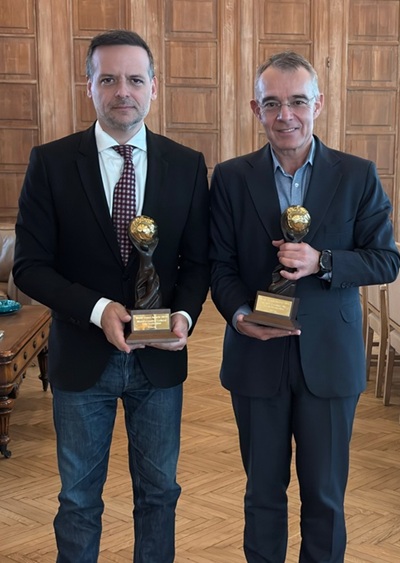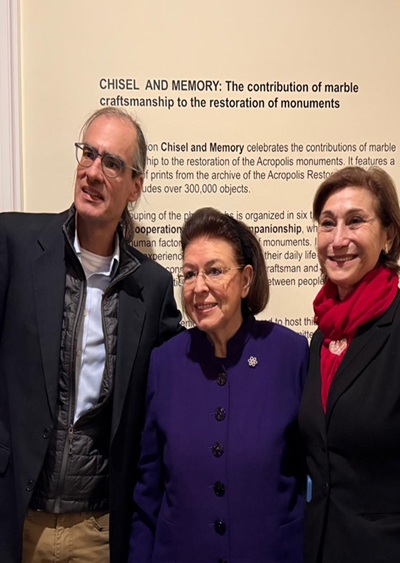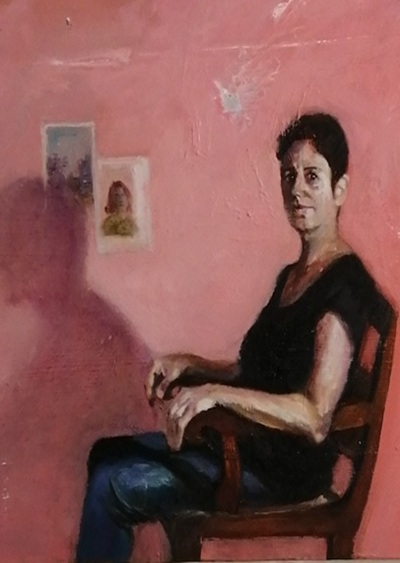
Homo ludens Thodoris Bargiotas plays painting.
“A painter, a lawyer, and a comic book maker enter a bar.” This could be the beginning of an anecdote in the classic motif of disparate characters who “walk into a bar” (a bear and a hunter, an Englishman, a German and a Greek, a yogurt and a deer, etc., Mr.). These anecdotes are based, on the one hand, on the alienation of the creatures who enter the bar and, on the other, on the relation between them, which, through comparison, will give rise to the unforeseen last phrase. But what if the three seemingly disparate characters are one? The Triune Thodoris Bargiotas condenses all three of them into one flesh and, with his works, proves that there is no need for three guys to enter the bar in order to start an interesting narrative. One is enough. And the last sentence does not need to be worded verbally; it arises effortlessly from the sight of all his paintings, quasi-frames that, next to each other, compose a loosely narrated (played?) comic book story.
But play, as Huizinga describes it, is on the one hand a necessary element of cultural production (while at the same time culture is a “source of misery” according to Freud, let’s not forget…), and on the other hand, it presupposes and promotes freedom. It is based on rules that, however, are modifiable, not timeless. Especially in music (“I play music,” don’t we say?) and dance, Huizinga recognizes the ultimate realization of play: “every genuine ritual is song, dance, and play. We moderns have lost our sense of ritual and sacred play. Our civilization has worn away over the centuries and is extremely varied and elaborate. In the enjoyment of music, whether it means the expression of religious ideas or not, the perception of beauty and the sense of sanctity merge, and the distinction between play and seriousness is lost in this fusion.” For the visual arts, however, the arts treated by Baryotas and Huizinga, though more sparing, reserve a different position. The determinants of which are competition and the way works of art are accepted by the social environment
And here come Baryota’s rituals to “correct” Huizinga and attempt to invite their viewers to an almost tactile, flavorful, olfactory game of losing seriousness. Mostly because in many of these works, Baryota’s aim is for the viewer to penetrate the work, to feel, to hurt, to be disturbed, to enjoy, and to set up his own narrative of what preceded and, perhaps more importantly, of what follows. It can be no coincidence, moreover, that in many of the works, the character, to speak in scriptural terms, who feels the consequences of the preceding narrative is a self-portrait version of Thodoris Bargiotas.
Beyond all religiosity in the strict sense, Baryotas’ works represent small rituals in which viewers are invited to participate and co-shape the terms and rules of the game. Archetypal poses and images marked by great works of the past, such as Rembrandt’s Anatomy Lesson (renamed Dirty South Farewells: Best Party Ever), become games, not of competition nor comparison, but of post-diacimatic (according to Gérard Genette) and diacimatic (according to Margaret Rose) adaptation and re-framing in a world that has renounced the causes of its rituals but continues to apply and reproduce them mechanically. With new means and for new purposes (sometimes without).
Perhaps that is why in the works of Baryotas, the ignorant, the superstitious, and the spineless of Goya are transformed into the essence of “all of us,” who do not run for our lives, do not scare, and do not hide, preferring to consume fluffy hamburgers in front of glowing screens. And perhaps, for the same reason, the dead Baryotas, like a pharaoh in his own anatomy lesson, carries with him to the other world his fortune—an enigmatic cube—while a frantic party is being set up around him and a lit laptop is being prepared for live streaming.
All this with a methodology and an argument that aim not at rhetoric but at something like a conclusion, something like the argument of a wavering lawyer in a court who pretends to seek to convince but will accept any decision without appealing—that’s the game; you accept the outcome, whatever it is, and all over again. Bargiotas, in many of his works, speaks by presenting and exhibiting a Studium against Roland Barthes. A familiar situation, legible writing, a figurative big picture In each, however, it inserts one (or more) punctum. In other words, details that magnetize the gaze and distort history to the extent that they claim the primacy of the subject (the cube we were talking about, a pen, a straw, a screen, a look) Interrupting small rituals, turning them into toys. By convincing us that they are toys.
And then the bar door reopens, and a painter, a lawyer, and a comic book creator walk in again. So they can all play painting together.
Giannis Koukoulas
Art Historian
“The paintings of Thodoris Bargiotas are an invitation, an invitation to see up close but also the lure of a magician who wishes to convert you. You need to get closer, wondering if what you are seeing is some kind of collage or strange photo, looking for signs of torn papers and associations that are not visible from afar. From far away, you can see a connected ensemble shining from within with an eerie light, as if you are dealing not with oil on canvas but with constructions, like boxes with artificial light sources, maybe even like an iconostasis with a lamp burning in the corner incessantly. What you will discover, however, as you approach, is the sign of the brush, the magical intrusive power of gesture, which sometimes gently unites forms, sometimes breaks through what is expected in his compositions.
Plastic mastery hypnotizes us initially so that we can stand still and become partakers of the mystery of childhood, of mischief, (like stories drawn from a parallel Balkan universe of the Lord Of The Flies) but also of the mysteries of love and death at the same time.
Influenced by a Tom Sawyer-like childhood in the southern states of the United States, his works are shaped by stories seen from the (not so) innocent look of a child struggling with the apparent maturity of an adult, and perhaps the perpetual tug of war is the life-giving power of his works.
Small rituals: they are the daily morning preparation of coffee, the reading of a prayer book, the group expressions of frenzy and tension, the purifying touch of a magic wand. Some gloomy and mysterious, others Radiant and diademous, surely all Bargiota’s performances are ritualistic.
Bargiotas invites us and prepares us, through the tireless play of shadow and light that creates conditions of sanctity, to discover and Share our own personal, annihilated, innocent, sinful rituals, recognizing in his paintings elements from our own experiences.
This is not what those who successfully convert do?”
Andreas Spiliotopoulos
Architect, Visual Artist
Biography of the artist
Born in 1982, he grew up in Tennessee, the USA, and Athens. As a child, he created myths and painted them.
In 2004, he graduated from the Law School of Athens and, in 2005, from the Law School of Strathclyde in Glasgow (postgraduate degree LLM). He worked as a lawyer in Athens until 2011, when he decided to quit it all and dive into art.
He graduated with honors from the Athens School of Fine Arts (third painting workshop) and then received a master’s degree in fine art from the University of Oxford (with distinction) as a fellow of the Neon organization. Because he missed the South, he ended up teaching painting at Louisiana State University in Louisiana, USA, where he also completed a doctoral thesis on the philosophy of genetics and received the title Doctor of Design.
He has participated in exhibitions in Greece, the U.S., and Britain and has published two books in Greece (Pernilongo 2012, Marmalade 2014). Since 2021, he has lived in Athens, where he teaches painting and continues to paint his stories, as he has done since he was a child.
Opening: Friday, May 5, 2023, at 19:00
Duration: May 5 to May 27, 2023
Curated by Michael Vassiliadis







Leave A Comment